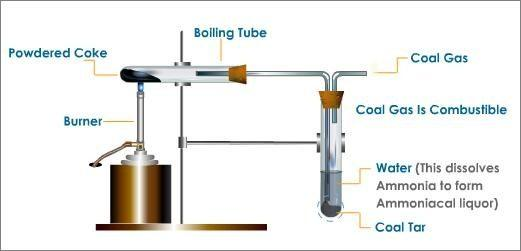
Destructive distillation of coal leads to the formation of!
A) Wood
B) Kerosene
C) Ammonia liquor
D) Charcoal
Answer
416.2k+ views
Hint: Coal when heated without air doesn’t burn but produces many by-products. The products of destructive distillation are different from that of combustion.
Complete step by step answer:
Destructive distillation is the process of decomposing a material by heating in a closed container in an inert atmosphere and collecting off the volatile constituents. Destructive distillation of coal produces many by-products. In the process, heated coal turns into coke, ammonia dissolves in water to form ammonia liquor and coal gas and coal tar are also produced. The apparatus for destructive distillation used in laboratory is shown below:

Process of destructive distillation:
In this process, coal is taken in a test tube and heated. Coal breaks down to produce coke, coal tar, ammonia and coal gas. Coal tar is collected at the bottom of the other test tube and coal gas escapes out of it. Ammonia is absorbed in water which forms ammonia liquor \[N{H_4}OH\]. The residue left in the parent test tube is coke.
Hence, the correct answer is (C) ammonia liquor
Additional information: Coal is a very important fossil fuel. It has a variety of uses:
It is an important means of electricity generation.
It is also used in steel production.
It is also used in filters for water and air purification and in kidney dialysis machines.
Note: A student might mistake it for the combustion of coal. Combustion is the burning of a substance in the presence of Oxygen. The products of combustion of coal are CO (Carbon Monoxide) and \[C{O_2}\] (Carbon Dioxide).
Complete step by step answer:
Destructive distillation is the process of decomposing a material by heating in a closed container in an inert atmosphere and collecting off the volatile constituents. Destructive distillation of coal produces many by-products. In the process, heated coal turns into coke, ammonia dissolves in water to form ammonia liquor and coal gas and coal tar are also produced. The apparatus for destructive distillation used in laboratory is shown below:

Process of destructive distillation:
In this process, coal is taken in a test tube and heated. Coal breaks down to produce coke, coal tar, ammonia and coal gas. Coal tar is collected at the bottom of the other test tube and coal gas escapes out of it. Ammonia is absorbed in water which forms ammonia liquor \[N{H_4}OH\]. The residue left in the parent test tube is coke.
Hence, the correct answer is (C) ammonia liquor
Additional information: Coal is a very important fossil fuel. It has a variety of uses:
It is an important means of electricity generation.
It is also used in steel production.
It is also used in filters for water and air purification and in kidney dialysis machines.
Note: A student might mistake it for the combustion of coal. Combustion is the burning of a substance in the presence of Oxygen. The products of combustion of coal are CO (Carbon Monoxide) and \[C{O_2}\] (Carbon Dioxide).
Recently Updated Pages
Using the following information to help you answer class 12 chemistry CBSE

Full Form of IASDMIPSIFSIRSPOLICE class 7 social science CBSE

In case of conflict between fundamental rights of citizens class 7 social science CBSE

Can anyone list 10 advantages and disadvantages of friction

What are the Components of Financial System?

Complete the letter given below written to your Principal class null english null

Trending doubts
Show variation of resistivity of copper as a function class 12 physics CBSE

Electrolysis of dilute H2SO4 generates H2S2O8 What class 12 chemistry CBSE

Explain with a neat labelled diagram the TS of mammalian class 12 biology CBSE

How do you convert from joules to electron volts class 12 physics CBSE

A convex lens is placed in water Its focal length A class 12 physics CBSE

Distinguish between asexual and sexual reproduction class 12 biology CBSE




